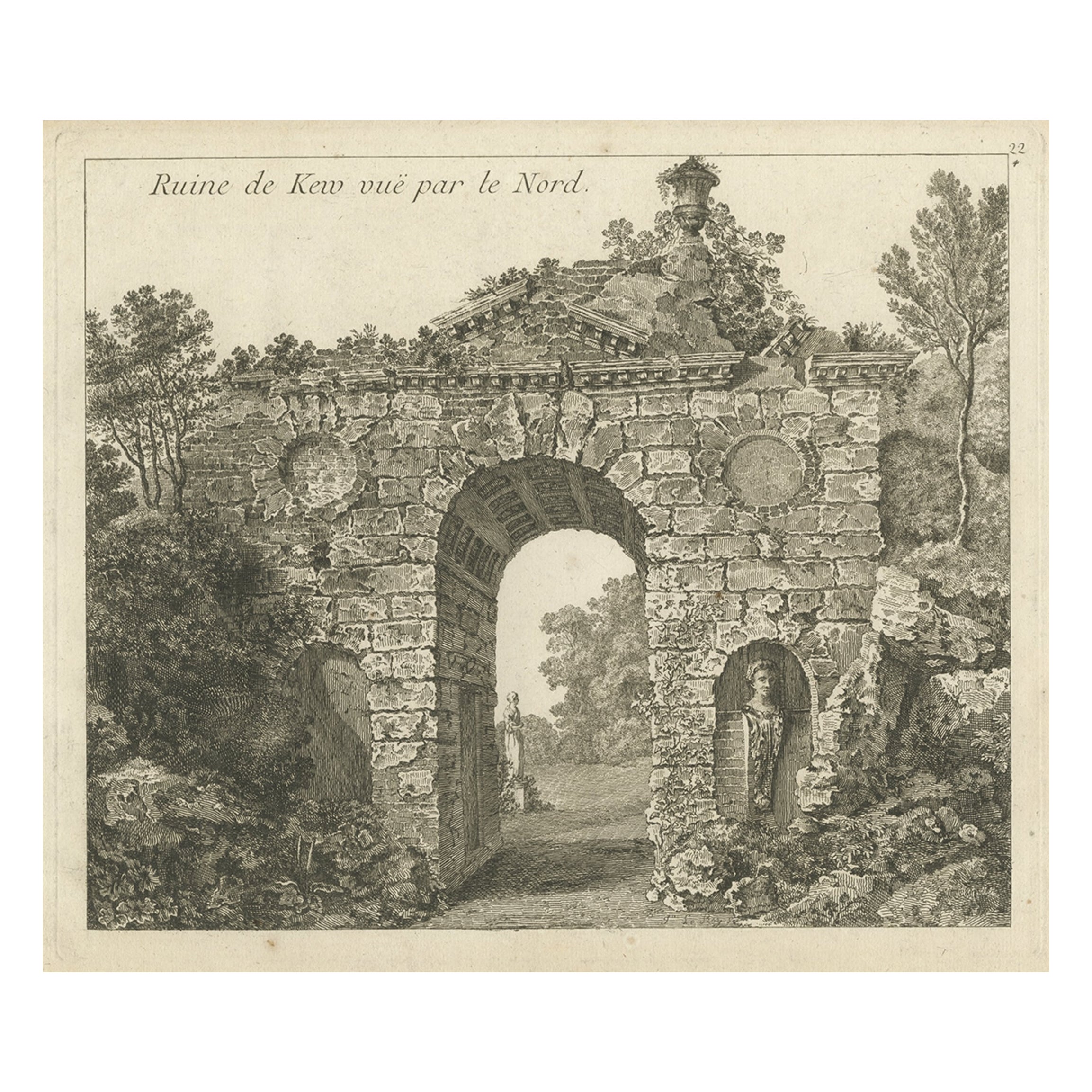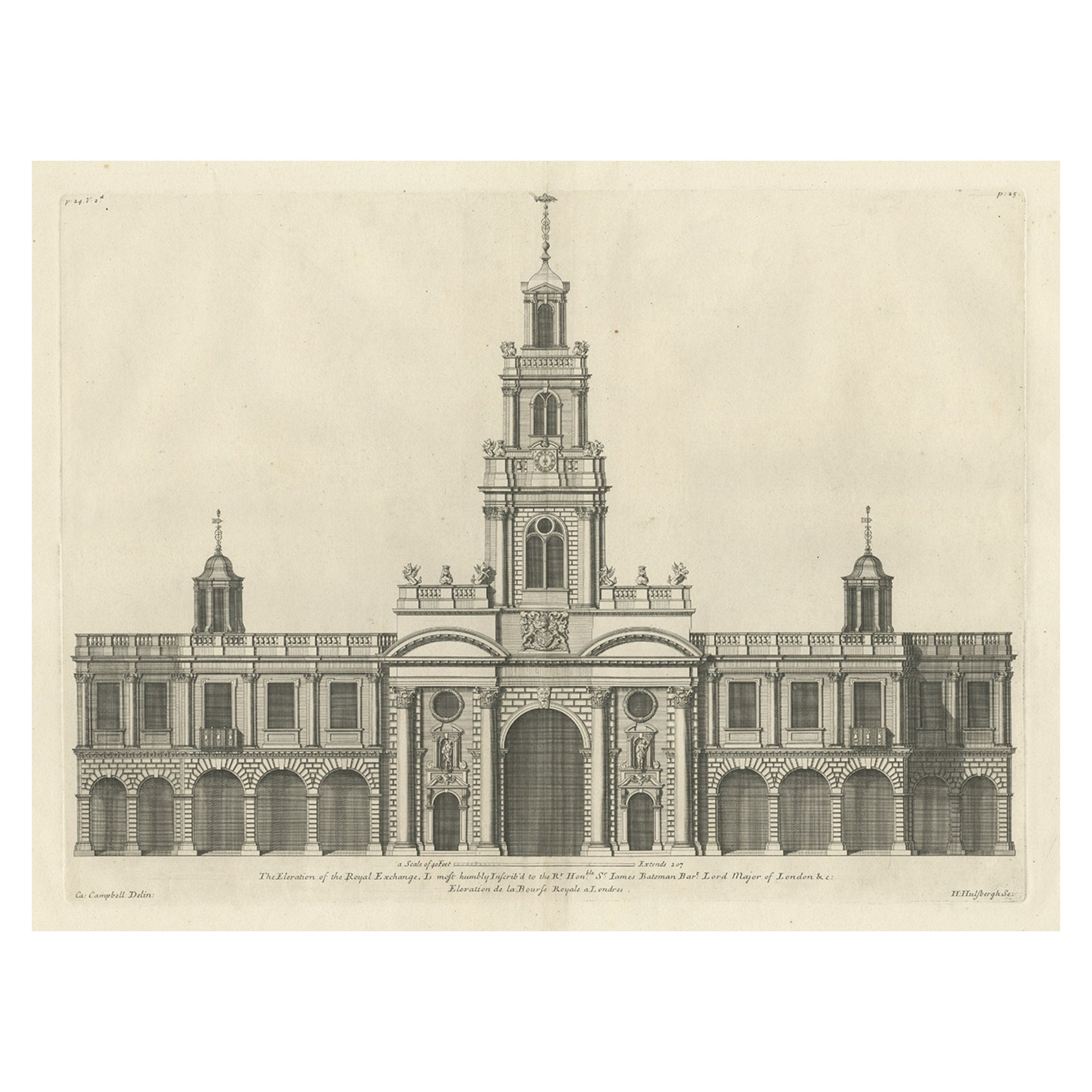Items Similar to Copper Engraving of a Section of the Royal Botanic Gardens, Kew, London, 1776
Want more images or videos?
Request additional images or videos from the seller
1 of 5
Copper Engraving of a Section of the Royal Botanic Gardens, Kew, London, 1776
About the Item
Antique print titled 'Coupe sur la longueur d'une partie de la Galerie des Antiques dans les jardins de Kew'.
Copper engraving showing a section of the Royal Botanic Gardens, Kew. This print originates from 'Jardins Anglo-Chinois à la Mode' by Georg Louis le Rouge.
Kew Gardens is a botanic garden in southwest London that houses the "largest and most diverse botanical and mycological collections in the world". Founded in 1840, from the exotic garden at Kew Park, its living collections includes some of the 27,000 taxa curated by Royal Botanic Gardens, Kew, while the herbarium, which is one of the largest in the world, has over 8.5 million preserved plant and fungal specimens. The library contains more than 750,000 volumes, and the illustrations collection contains more than 175,000 prints and drawings of plants. It is one of London's top tourist attractions and is a World Heritage Site.
Kew Gardens, together with the botanic gardens at Wakehurst in Sussex, are managed by the Royal Botanic Gardens, Kew, an internationally important botanical research and education institution that employs over 1,100 staff and is a non-departmental public body sponsored by the Department for Environment, Food and Rural Affairs.
The Kew site, which has been dated as formally starting in 1759, though it can be traced back to the exotic garden at Kew Park, formed by Henry, Lord Capell of Tewkesbury, consists of 132 hectares (330 acres) of gardens and botanical glasshouses, four Grade I listed buildings, and 36 Grade II listed structures, all set in an internationally significant landscape. It is listed Grade I on the Register of Historic Parks and Gardens.
Kew Gardens has its own police force, Kew Constabulary, which has been in operation since 1847.
Artists and Engravers: The work of Le Rouge is considered the most important engraved work concerning the history of European gardens during the 18th century.
Condition: Good, general age-related toning. Minor wear, please study image carefully.
- Dimensions:Height: 10.83 in (27.5 cm)Width: 16.15 in (41 cm)Depth: 0 in (0.02 mm)
- Materials and Techniques:
- Period:1770-1779
- Date of Manufacture:1776
- Condition:
- Seller Location:Langweer, NL
- Reference Number:
About the Seller
5.0
Platinum Seller
These expertly vetted sellers are 1stDibs' most experienced sellers and are rated highest by our customers.
Established in 2009
1stDibs seller since 2017
1,946 sales on 1stDibs
Typical response time: <1 hour
- ShippingRetrieving quote...Ships From: Langweer, Netherlands
- Return PolicyA return for this item may be initiated within 14 days of delivery.
More From This SellerView All
- Antique Print of a Section of the Kew Gardens, London, England, c.1785Located in Langweer, NLAntique print titled 'Coupe sur la longueur d'une partie de la Galerie des Antiques dans les jardins de Kew'. Copper engraving showing a section of the Royal Botanic...Category
Antique 18th Century Prints
MaterialsPaper
- Copper Engraving Showing a Labyrinth & the Hermitage of Versailles France, 1776Located in Langweer, NLAntique print titled 'L'Hermitage à Versailles - Labyrinthe d'Abano au Prince Mocenigo - Projet d'un Labyrinthe par Bettini'. Copper engraving showing a Labyrinth and the Hermita...Category
Antique 1770s Architectural Models
MaterialsPaper
- Antique Print of a Ruin of the Kew Gardens in London, England, c.1785Located in Langweer, NLAntique print titled 'Ruin de Kew vuë par le Nord'. Copper engraving of a ruin of the Kew gardens. This print originates from 'Jardins Anglo-Chinois à la Mode' by Georg Louis le Rouge. Artists and Engravers: The work of Le Rouge is considered the most important engraved work concerning the history of European gardens during the 18th century. Kew Gardens is a botanic garden in southwest London that houses the "largest and most diverse botanical and mycological collections in the world". Founded in 1840, from the exotic garden at Kew Park, its living collections includes some of the 27,000 taxa curated by Royal Botanic Gardens, Kew, while the herbarium, one of the largest in the world, has over 8.5 million preserved plant...Category
Antique 18th Century Prints
MaterialsPaper
- Engraving of the Entrance Facade of the Royal Exchange, Cornhill, London, 1725Located in Langweer, NLAntique print titled 'The Elevation of the Royal Exchange (..)'. Old engraving of the entrance facade of the Royal Exchange, Cornhill. This print originates from 'Vitruvius Brita...Category
Antique 1720s Architectural Models
MaterialsPaper
- Antique Print of the Royal Botanic Gardens of Melbourne, Australia, c.1890Located in Langweer, NLAntique print titled 'Melbourne, the Botanic Gardens'. Old print of the Royal Botanic Gardens Victoria, Australia. This print originates from 'The Aust...Category
Antique 19th Century Prints
MaterialsPaper
- Pl. 5 Antique Print of the Hydraulic Machine of the Kew Gardens by Le Rouge, c.1Located in Langweer, NLAntique print titled 'Machine Hydraulique dans les Jardins de Kew (..)'. Copper engraving showing the hydraulic system of the Kew gardens and the cave of Chiswick. This print origina...Category
Antique 18th Century Prints
MaterialsPaper
You May Also Like
- Antique Map of the Royal Botanic Garden & Arboretum Kew in London, EnglandLocated in San Diego, CAA very nice antique map of the Royal Botanic Garden & Arboretum in London, England, circa 1880s. The map itself measures 12" x 16" and is professionall...Category
Antique Late 19th Century English Prints
MaterialsPaper
- Engraving on Copper Print from the Volume Navigazione Nautical Subject 1790Located in Milan, ITPrint by engraving on copper plate Tav III TIX fig. 17-22 from the volume Navigazione; with frame 28 x 33. Some calculations are depicted. Very good condition. Shipping is insured by...Category
Antique 1790s Italian Nautical Objects
MaterialsPaper
- Albrecht Dürer "The Small Horse, " 19th Century Copper Plate EngravingBy Albrecht DürerLocated in Barcelona, ES"The Small Horse" copper plate engraving by Albrecht Dürer, circa 1505. This is a 19th century engraving, printed in black on laid paper, framed by a beautiful gilt and ebonized carv...Category
Antique Late 19th Century French Renaissance Prints
MaterialsWood, Paper
- “The Restaurant of the House of Representatives” Engraving by Harper's WeeklyLocated in Colorado Springs, COThis original wood engraving is titled “The Restaurant of the House of Representatives, Washington, DC.” It was published as a double-page image, in the August 12, 1893 issue of the famous 19th century newspaper Harper’s Weekly. The print was illustrated by Charles Stanley Reinhardt. The House Restaurant, a unique part of life in the Capitol, has been in the same location since the 1857 Capitol Expansion. Congressional members’ busy work schedule made the availability of food on site a necessity. But the restaurant also served as an informal meeting spot for members to continue conversations and deal making. This 1893 print illustrates the convivial atmosphere. Details including elegantly dressed tables...Category
Antique 1890s American Prints
MaterialsPaper
- 1876 "Gettysburg, The Repulse of Longstreet's Assault." EngravingLocated in Colorado Springs, COPresented here is an 1876 engraving of John B. Bachelder and James Walker’s Gettysburg. The Repulse of Longstreet’s Assault. The engraved scene depicts the decisive battle on the final day of the Battle of Gettysburg. Researched by the photographer and topographer John B. Bachelder and painted by James Walker, the original painting was created in 1870. This detailed engraving was done by H. B. Hall Jr. and published by James Drummond Ball. Otherwise called Pickett’s Charge, the battle occurred on July 3, 1863. Pickett’s corp commander, Lieutenant General James Longstreet was placed in charge of the attack despite his hesitations. Longstreet’s central role led to the title of the work, Repulse of Longstreet’s Assault. In an attempt to gain control of an important supply route, nine Confederate brigades charged across three-quarters of a mile of open ground against cannon fire to take Cemetery Ridge from the defending Union Army. Despite their overwhelming numbers, the Confederate forces were repelled with considerable casualties marking not only a decisive victory for the Union, but also the beginning of the slow defeat of Lee’s Army. The furthest the charging forces advanced before being repulsed would forever be known as the “High Water Mark of the Confederacy.” The Confederate army never recovered from the losses at Gettysburg and it effectively ended Lee’s campaign into Pennsylvania. The engraving gives the perspective from the Union rear, one that encompasses most of the battlefield, from Big Round Top on the left to the northern reaches of Cemetery Ridge on the right. The Confederate lines at Seminary Ridge are in the far distance, partially obscured by bursting shells. The image centers on the main Confederate assault, in the vicinity of what today are known as "The Copse" and "The Bloody Angle." The composition has elemen...Category
Antique 1870s American Prints
MaterialsPaper
- Set of Twelve Colored Engravings of the Defeat of the Spanish Armada by J. PineLocated in Essex, MABy John Pine considered the foremost heraldic and decorative engraver of his generation. Depicting the defeat of the Spanish by the English Fleet in 1588. These are after a set of tapestries that hung in the House of Commons...Category
Antique 1740s English Prints
MaterialsPaper
Recently Viewed
View AllMore Ways To Browse
Architectural Study
Architectural Studies
Body Model
House Model
Model Of House
Model 36
A Collection Of Botanical
Important Royal
Antique Copper Engravings
Set Of Botanicals
Royal Botanical
Architectural Model House
Architecture Building Model
Plant Model
Set Of Four Engravings
Antique Botanical Illustrations
Botanical Study Set
Set Of Botanical Studies





